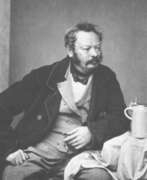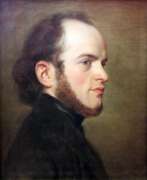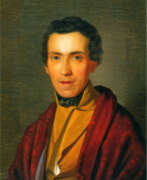Landscape painters Biedermeier




Heinrich Bürkel was a German artist of the mid-nineteenth century. He is known as a painter and graphic artist, representative of the Biedermeier style.
Heinrich Bürkel specialized in genre and landscape paintings, especially winter landscapes. He often used Staffage and depicted animals. His work showed the influence of the old Dutch and Italian masters. Bürkel enjoyed great popularity, his paintings were actively acquired for private collections, including in America. The master painted about 1000 paintings and created about 6000 drawings.


Paul Walter Ehrhardt was a German painter of the Munich School. Paul W. Ehrhardt studied with Max Thedy at the Grand Ducal Saxon Art School in Weimar and with Paul Hoecker at the Academy of Fine Arts in Munich. From 1906 he exhibited regularly in the Munich Glass Palace and at the Great Berlin Art Exhibition. Ehrhardt painted atmospheric Biedermeier interiors in muted tones. During the Nazi regime he was one of the most sought-after artists. Except for 1938, from 1937 to 1944 he was represented with 19 paintings at seven Great German Art Exhibitions in Munich, of which Hitler acquired three and the Nazi leader Joachim von Ribbentrop one. His works were represented at auctions until 2006.


Johann Philipp Eduard Gaertner was a German painter of the second quarter of the 19th century, the Biedermeier era. He is known as a landscape painter, famous for his views of Berlin and other cities.
Eduard Gaertner created many architectural landscapes of Berlin, as well as St. Petersburg and Moscow during his travels to Russia. The value of these works is that they documented the appearance of the cities on the eve of the age of photography. Gaertner's painting style underwent a change after the death of King Friedrich Wilhelm III, his patron. In keeping with the cultural attitudes of Prussia's new ruler, the artist began to paint more romantic and idealized landscapes in which architecture played a decorative role.


Joseph Anton Koch was an Austrian painter, draughtsman and printmaker, master of etching and illustration, novelist and representative of the classicist landscape in German art. In his native country he was associated with the Biedermeier aesthetic, and in Rome with the Nazarene society.


Friedrich Loos was an Austrian Biedermeier style painter, etcher and lithographer.
He studied at the Vienna Academy with Joseph Mössmer and also went on study tours through the Austrian Alpine regions. From 1835 to 1836 he lived in Vienna, and as of 1846 he sojourned in Rome. He then moved to Kiel, where he worked as a drawing teacher at the university as of 1863.


Peter Mayr was a German artist, born in 1758 in Freiburg/Breisgau and active until his death in 1836 in Munich. He was renowned for his miniature paintings, a craft in which he demonstrated exceptional skill and artistry. Peter Mayr's works were primarily executed in gouache and watercolor, showcasing his ability to capture intricate details and convey the essence of his subjects on a miniature scale.
His works, such as "Dancing peasants before a tavern" and classical representations like "Venus and Cupid" and "Reclining Venus," reveal his versatility and the influence of other artists, like David Teniers, in his creations. These artworks not only highlight his proficiency in miniature painting but also his engagement with various themes and subjects, ranging from everyday scenes to classical motifs.
Peter Mayr's art has been valued and auctioned at various reputable platforms, emphasizing his significance in the art world. His miniatures, often set in elaborate frames and executed with precision, are collected and admired for their historical and artistic value.
Collectors and art enthusiasts continue to celebrate Peter Mayr's contributions to miniature painting, and his works remain a testament to his skill and dedication to this intricate art form. For updates on new discoveries or auction events related to Peter Mayr's works, sign up for our newsletter to stay informed.


Lorenzo Quaglio was an Italian-born German painter of the first half of the 19th century. He is known as a painter, landscape painter, genre painter and lithographer of the German Biedermeier period, a member of the Quaglio dynasty of artists, brother of the famous architect-artist Domenico Quaglio.
Lorenzo Quaglio worked early in his career as a decorator for the court of the Bavarian Electorate and the national theater in Munich. He traveled frequently in the Bavarian and Tyrolean Alps, which inspired him to create. His works predominantly depicted scenes from the peasantry of Upper Bavaria. He also executed on stone copies of paintings from the Dresden Gallery. In 1812, he created his first lithograph with nature scenes, and from 1820 he studied Bavarian folk costume. Later he worked on the decoration of the Swan Knight Hall in Hohenschwangau Castle.


Adolph Friedrich Erdmann von Menzel was a German Realist artist noted for drawings, etchings, and paintings. Along with Caspar David Friedrich, he is considered one of the two most prominent German painters of the 19th century, and was the most successful artist of his era in Germany. First known as Adolph Menzel, he was knighted in 1898 and changed his name to Adolph von Menzel.
His popularity in his native country, owing especially to his history paintings, was such that few of his major paintings left Germany, as many were quickly acquired by museums in Berlin. Menzel's graphic work (and especially his drawings) were more widely disseminated; these, along with informal paintings not initially intended for display, have largely accounted for his posthumous reputation.


Anton Zwengauer was a German painter of the mid-19th century. He is known as a landscape painter and is considered a representative of the Biedermeier artistic movement.
Zwengauer traveled extensively in the Alps early in his career, creating sketches and watercolors. His painting "Sunset at Dachauer Moos" brought him recognition, and "sunsets" became his characteristic subject, known as "Zwengauers". The artist sought to convey the inner strength and peace of nature, often depicting sunsets and creating impressive lighting effects through simple means.









